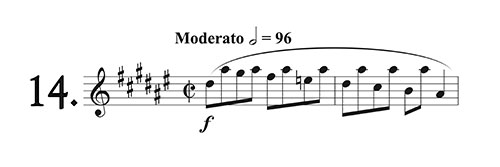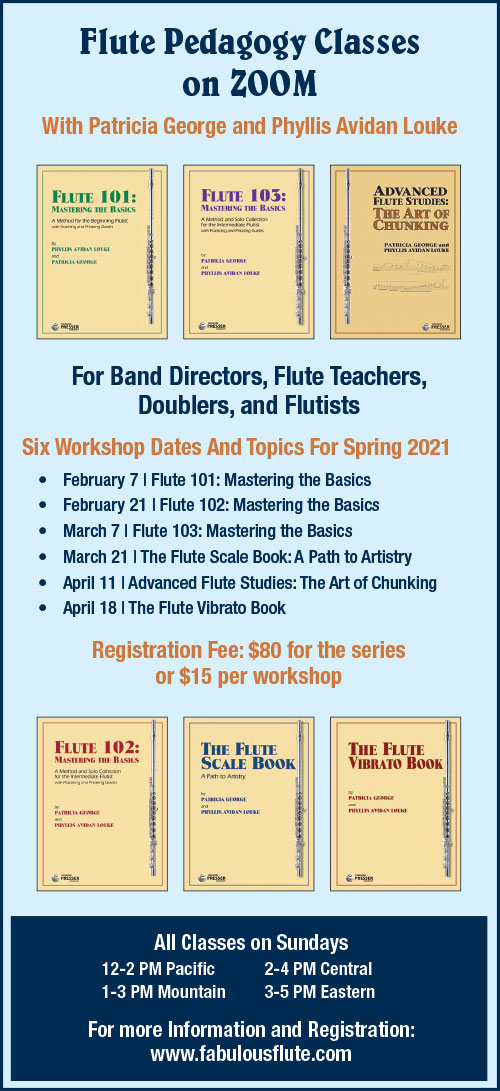As teachers our mission is to help the student learn to play well. However, after teaching the literature for a few years, it becomes obvious that students have difficulties in the same passages in the repertoire. In a masterclass James Pellerite, Indiana University professor emeritus, suggested that in troublesome passages, you should analyze what the problem is and then either write an etude to fix the problem or find an etude in the repertoire that solves this issue. Otherwise, for your entire life, when playing this composition, the chatter in your brain will be something like, “Page 3, line 2–difficult.” These are not the thoughts to be having when performing.
D’s and E’s
Two of the most common fingering problems on the flute are putting the right-hand pinkie on or down for E in the first and second octaves and lifting the left-hand index finger for the D in the middle octave. These notes are found in almost every composition. As teachers we stop the student and correct the fingering, and sometimes even circle in red pencil all of the places where the right-hand pinkie is on or when the left index finger is lifted. Taking Pellerite’s advice in finding an etude that addresses these issue leads us to Joachim Andersen’s Op. 30, 24 Instructive Studies, No. 5 in D Major. Throughout this 96-measure etude, these fingering issues are highlighted in almost every measure. In my own studies, once I could execute this etude perfectly at a brisk tempo, my fingering problems were solved.

Balancing the Flute
Balancing the flute in the hands is an issue that has been overlooked in pedagogy. First of all, most teachers say, “Hold the flute” which may imply grasping the flute. Using the word “balancing” takes the tension off the hands, arms and shoulders. Once the flute is balanced, then only the fingers move. Fingers move from the third knuckle back except for the left-hand index finger. The right-hand knuckles should be the same height as the finger tips on the keys. Once a student balances the flute well, then the next issue to watch for is the end of the flute rising when fingers are being removed in ascending scales and then the end of the flute lowering on the descent.
Repair people refer to the keys in the left hand as the upper stack, and the keys of the right hand as the lower stack. To achieve balance where the flute is stationary and balanced in the hands or balanced between the two stacks, alternate trilling the first key in the right hand or lower stack (F to G) with the last key of the upper stack (G to A). Once a student can successfully do this without the flute moving, then true balance has been achieved.
Another balance issue occurs when going between the top notes of the upper stack (B or C) to the lower notes of the right stack (D or E). Andersen’s Op. 30, No. 6 offers a wonderful exercise to solve this balance issue.

Chipping the First Note
The term “chipping” comes from the brass world and refers to not having a clean, perfect attack on a note. If the chip or crack is high, then the flutist needs to lower the air stream on the wall. If the chip is low, then the flutist raises the air stream. Recording your playing on a phone and listening back immediately helps you to make the right decision about aiming the air stream. William Kincaid, legendary pedagogue and the father of American flute playing, suggested practicing Andersen’s Op. 30, No. 3 quite slowly. He set the tempo at eighth note = 60. Each note was to be played staccato or half-value. He called this exercise “A Page of First Notes.” During the rest, the tongue is replaced in the aperture.


Mordents
A mordent is an ornament in which there is a quick alteration from the written note to the note above and back. It is executed in a short, short, long rhythmic pattern. The first note of the mordent is played on the beat. Students rush and often play the first note before the beat with the middle note of the mordent landing on the beat. Once again, Andersen has offered a solution to this issue in Op. 30, No. 12. This etude is in ABA form. In the A sections, Andersen slows down the mordent rhythm so the flutist plays two sixteenths followed by an eighth. A few conductors have suggested playing mordents as triplets, but this thankfully has gone out of vogue.

In the B section, the mordents are used. The rhythmic relationship is the same for the mordents.

Many a Kincaid student agonized with these 32-measures in the B section of the etude. Kincaid was insistent that each mordent was played in time with the correct proportions and of course trill fingerings. His pickiness was worth the effort as many an audition has been won by a student who had control of mordents.
Jaw-Boning
Many students move the embouchure and/or the jaw much more than necessary when playing. To practice moving very little if any, play five-note patterns (Taffanel et Gaubert, Nos 1 and 2) slurred. Most of these patterns can be played without moving the embouchure. Since this exercise begins on the lowest notes of the flute, many flutists try to play higher five-note patterns with a low-note set embouchure. Joseph Mariano commented, “You can play low notes with a high embouchure, but not high notes with a low embouchure.” To set the embouchure high for low notes, play a top octave B or B flat, and then keep the lips set in this position when playing the lower patterns. Remember playing higher notes depends on the aperture size and the speed and angle of the air stream.
Andersen, Op. 30, No. 14 works on disjunct (not step-wise) intervals. Chunk each measure playing a high B before beginning the measure. The high B sets the embouchure making it easier to play the two bars without much movement. Once you can play with less movement, you will be able to play passages faster and efficiently.

What Changes?
In one of my first lessons with William Kincaid, I was playing Andersen’s Op. 30, No. 21. The entire etude is octaves. I was doing well and then I crashed and burned. At once Kincaid said you are thinking fingerings rather than which finger moves. This was a thought I had never had. So, I placed an X over all the octaves where fingers moved and suddenly I could play this without errors. I think the issue was that I knew the fingers moved someplace, but which octaves I could do by overblowing and which ones needed a fingering change was not organized in my mind. For my future practice, I created an exercise where I played chromatic octaves starting on C in the staff and ascending until I reached the top C. Before playing each octave, I said aloud “the same fingering" or noted which fingers moved. For example, for octave F’s, I said, “Lift the A finger.” For G, “Take off thumb.”

Etudes by flutist composers (Altes, Andersen, Berbiguier, Kohler, Hugues) generally focus on the technical issues of flute playing. Etudes by non-flutist composers (Genzmer, Karg-Elert, Bozza, Casterede) however offer a rich repertoire for musical phrasing and tone color work.








